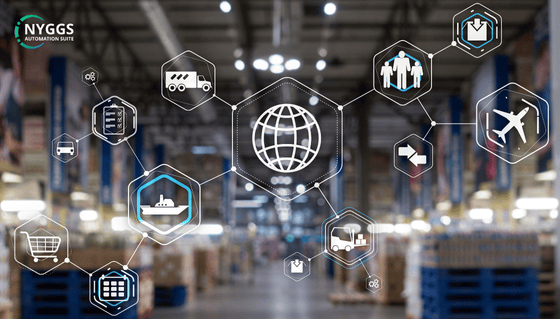What if your supply chain predicts disruptions before they happen?
Table of Contents
ToggleAnd not just predict but also suggest the fixes to combat this chaos?
Supply Chain Management in ERP systems will do that.
By 2025 and beyond, big technologies like AI, Blockchain, IoT, and other innovations will be fuelling this double-power system, making it intelligent and connected. The result? A smarter supply chain that is more predictive, resilient, and self-healing.
This blog puts light on exactly these revolutionary technologies. You will know how each of these will transform your business’s supply chain. Also, how NYGGS ERP brings this dual power to one place that eases supply chain management by 2x. Let’s dive straight in.
AI Revolution in Supply Chain ERP
AI is now the backbone of any digital system, including Supply Chain Management in ERP. Because AI is not just automating tasks but making intelligent decisions faster. When AI/ML connect with SCM in ERP, they teach the system to act automatically on repeated tasks. Additionally, the AI/ML-powered SCM fixes itself to resolve frequently occurring errors. That is why AI is capable of:
- Intelligent Demand Forecasting. AI models use sales history, market trends, weather, and even social media signals to create DYNAMIC forecasts. Some companies have stated that they improved forecast accuracy by 40% when using AI.
- Building an Autonomous Inventory Optimisation System. Machine learning predicts stock levels, replenishes high-demand items, and flags slow-moving goods. Businesses have reported inventory turnover gains of 10–30%.
- Automating Data Entry. AI can read invoices, enter data automatically, and generate real-time executive reports. Now, there’s no need to wait for 5 hours for reports.
Ultimately, an AI-driven system is changing how businesses manage their core supply chain processes. Also, the AI is bringing automation in predictions with surprising accuracy.
Real-Time Analytics and Visibility
The world is rewriting supply chain rules almost daily. So, modern businesses can no longer wait for monthly reports to adjust strategies. Cloud ERP systems now deliver real-time insights, backed by actual data from your supply chain.
- Interactive Dashboards: Managers can track KPIs and get executive summary instantly and drill down for details.
- IoT Integration: IoT-powered sensors send live data of trucks, warehouses, and equipment performance. This gives a full view of the business condition.
- Effective Decision-Making: Real-time analytics use data to make agile decisions and help businesses stay competitive.
Digital Twins: Virtual Supply Chains
Digital twins make copies of our supply chain operations on the computer. These copied versions use live data from our ERP, IoT, and sensors to provide insights with real-world accuracy. Digital twins of supply chains help us in:
“What-if” Simulations. Basically, you can test different situations, like what happens if a supplier is late or if customer demand suddenly increases. All these scenarios can be run virtually without affecting the real-life supply chain. This helps us find the best way to optimise production plans, adjust logistics, and save money.
The Forbes article also confirms that when businesses use digital twins, they see up to 30% better forecasting accuracy.
Read More: What is the Difference Between Logistics and Supply Chain Management?
Blockchain for Trust and Transparency in SCM
In global supply chains, trust has always been a tricky issue. Documents get lost, records are tampered with, and partners often work in confusion. This is where blockchain, when connected with ERP, comes in handy. It creates a digital ledger that nobody can alter, but everyone in the chain can safely access.
Why it matters: it brings no tampering, as only authorised people have access to the data. It increases more transparency, stops fraud, and makes transactions safer. And it even allows smart contracts to run on their own. In short, blockchain helps fill the trust gap between different parts of supply chain management in ERP systems.
Robotic Process Automation (RPA) in SCM
RPA is quietly changing the way supply chains work inside ERP platforms. These bots take care of boring, repetitive jobs that usually eat up a lot of time.
Common examples: processing orders, updating inventory, shortlisting vendors, or even billing. Some businesses have managed to reduce process times by almost half in credit and collections through RPA. And now, bots are becoming “predictive”, meaning they don’t just follow rules but also learn from past data to suggest smarter actions.
IoT-Driven Supply Chain Intelligence
With IoT devices, ERP systems are moving into a new zone of intelligence. IoT-powered GPS trackers, fuel monitoring sensors and RFID tags to help us with:
- Predictive maintenance: IoT sensors can tell you about a possible breakdown in vehicles and machines before it actually happens.
- Smart manufacturing: Equipment shares real-time performance data, and you can predict the production timelines.
- Better visibility: RFID tags provide a live picture of inventory so you don’t end up with too much stock or too little.
Conclusion: Supply Chains of 2025 and Beyond
The future of supply chain management in ERP is not only about saving money or being faster. It is about building systems that can almost “think” on their own. Imagine software that senses demand changes days in advance by analysing weather patterns, political events, and even social trends. Supply chain management will become too easy and most sustainable.
To stay ahead, companies will need ERP solutions that naturally integrate AI, IoT, and automation. NYGGS ERP has been designed with exactly these strengths, serving industries like manufacturing, construction, mining and more. Additionally, NYGGS brings mobile-friendly ERP to give real-time visibility, predictive insights, and downloadable reports on their mobile phones.








